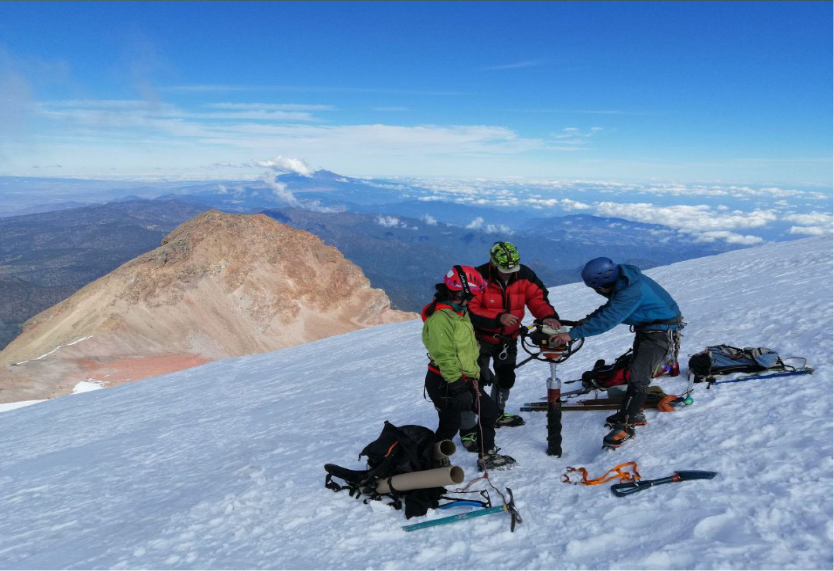Abstract
There is alarming news about the disappearance of glaciers around the planet. In Mexico there are still two small bodies of ice (glaciers) in high mountains in the center of the country: Iztaccihuatl (5215 meters above sea level, m a. s. l.) and Citlaltépetl (5626 m a. s.l.). These glaciers, located at 19o north latitude and receiving precipitation (snow) from both the Pacific Ocean and the Gulf of Mexico (Atlantic Ocean), and very close to important urban and industrial areas, contain an environmental record of heavy metals of great interest for comparison with Andean, North American, Alpine and Himalayan regions. Since 2006, the Centro de Geociencias UNAM, Campus Juriquilla, has been working on the collection of snow and ice samples from these Mexican glaciers for chemical analysis of major elements and heavy metals. Currently, we have a database from 2006 to 2022 to evaluate 16 years of monitoring concentrations of metals and present the results in an international publication. A preliminary analysis shows considerable concentrations of V, Cr, Ni, Cu, Zn, Pb, and Hg in snow and glacier ice comparable with data from the Sajama glacier in Bolivia. The concentration increase goes from pre-industrial time (natural values) to higher concentrations in the last decades. In this article, we describe modern environmental glacial geochemistry techniques, present some preliminary data as examples, and describe current UNAM projects in this line of research.
References
Barker, J. D., Kaspari, S., Gabrielli, P., Wegner, A., Beaudon, E., Sierra-Hernández, M. R., & Thompson, L. (2021). Drought-induced biomass burning as a source of black carbon to the central Himalaya since 1781 CE as reconstructed from the Dasuopu ice core. Atmospheric Chemistry and Physics, 21(7), 5615–5633. https://doi.org/10.5194/acp-21-5615-2021
Bergquist BA, Blum JD (2007) Mass-dependent and –independent fractionation of Hg isotopes by photoreduction in aquatic systems. Science 318:417–420
Borrok DM, Nimick DA, Wanty RB, Ridley WI (2008) Isotopic variations of dissolved copper and zinc in stream waters affected by historical mining. Geochim Cosmochim Acta 72:329–344
Bullen, T. (2011). Stable Isotopes of Transition and Post-Transition Metals as Tracers in Environmental Studies. In: Baskaran M (ed) Handbook of Environmental Isotope Geochemistry, Advances in Isotope Geochemistry, Springer.
Callender, E. (2014). Heavy metals in the environment – historical trends. In Treatise on Geochemistry (pp. 59–89). Elsevier.
Ferrari, C.P., Clotteau, T., Thompson, L., Barbante, C., Cozzi, G., Cescon, P., Hong, S., Maurice Bourgoin, L., Francou, B., Boutron, C. (2001). Heavy metals in ancient tropical ice: initial results. Atmospheric Environment, Vol. 35, p. 5809-5815.
Harvey MJ, Matthews KM (1989) 7Be deposition in a high-rainfall area of New Zealand. J Atmos Chem 8:299–306.
Larson PB, Maher K, Ramos FC, Chang Z, Gaspar M, Meinert LD (2003) Copper isotope ratios in magmatic and hydrothermal ore-forming environments. Chem Geol 201:337–350.
Lotfi-Kalahroodi E, Pierson-Wickmann AC, Rouxel, O (2021) More than redox, biological organic ligands control iron isotope fractionation in the riparian wetland. Sci Rep 11, 1933 (2021).
Mathur R, Ruiz J, Titley S, Liermann L, Buss H, Brantley SL (2005) Cu isotopic fractionation in the supergene environment with and without bacteria Geochim Cosmochim Acta 69:5233–5246.
Masarik J, Beer J (1999) Simulation of particle fluxes and cosmogenic nuclide production in the Earth’s atmosphere. J Geophys Res Atmos 104:12099–12111
Nriagu JO (1988a) A silent epidemic of environmental metal poisoning? Environmental Pollution 50: 139–161.
Nriagu JO (1990a) The rise and fall of leaded gasoline. Science of the Total Environment 921: 13–18.
Nriagu JO (1990b) Global metal pollution. Environment 32: 7–33.
Sierra-Hernández, M. R., Beaudon, E., Porter, S. E., Mosley-Thompson, E., y Thompson, L. G. (2022). Increased fire activity in Alaska since the 1980s: Evidence from an ice core-derived black carbon record. Journal of Geophysical Research Atmospheres, 127(2). https://doi.org/10.1029/2021jd035668
Nishiizumi K, Imamura M, Caffee MW et al (2007) Absolute calibration of Be-10 AMS standards. Nucl Instrum Meth Phys Res Sect B Beam Interact Mater Atoms 258:403–413.
Thompson, L. (2017). Past, Present, and Future of Glacier Archives from World’s Highest Mountains. Proceedings of the American Philosophical Society. Vol. 161, No. 3, pp. 226-243.

This work is licensed under a Creative Commons Attribution-NonCommercial 4.0 International License.
Copyright (c) 2023 Universidad Nacional Autónoma de México

